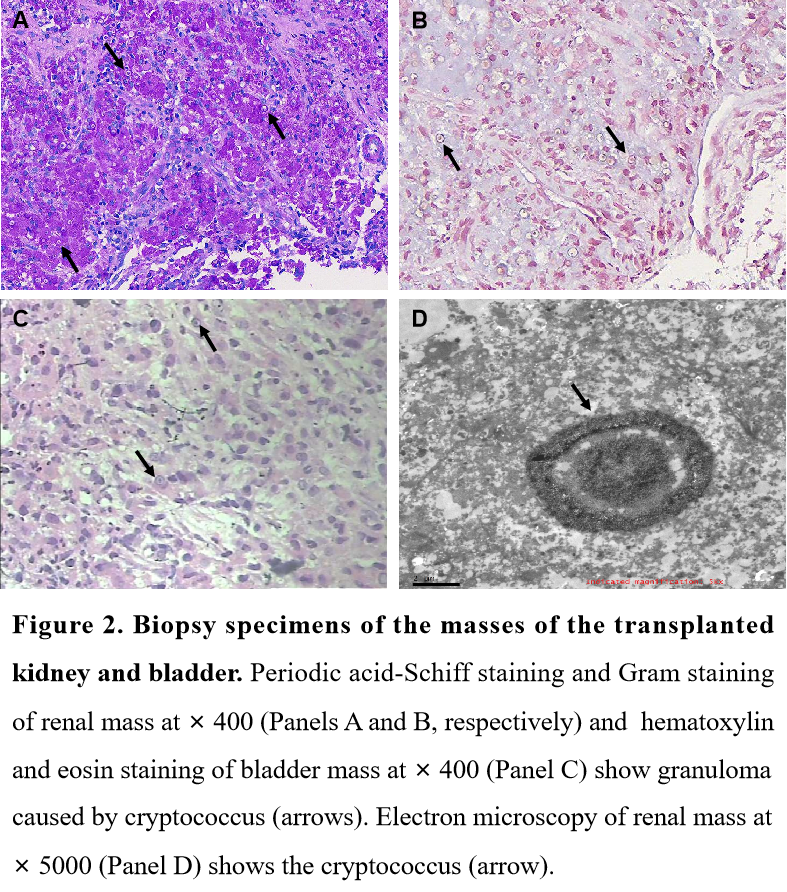Cryptococcoma due to Cryptococcus albidus of a transplant kidney in a patient presenting with recurrent urinary tract infection: A clinical and metagenome sequencing study
Ziyan Yan1, Yanna Liu1, Wenfeng Deng1, Hengrui Zhao2, Fangxiang Fu1, Renfei Xia1, Yuchen Wang1, Wenli Zeng1, Jian Geng3, Rumin Liu1, Jian Xu1, Chin-Lee Wu4, Yun Miao1.
1Organ transplant department, Nanfang Hospital, Southern Medical University, Guangzhou, People's Republic of China; 2Department of laboratory medicine, Nanfang Hospital, Southern Medical University, Guangzhou, People's Republic of China; 3Department of pathology, Nanfang Hospital, Southern Medical University, Guangzhou, People's Republic of China; 4Department of urology and pathology, Massachusetts General Hospital, Harvard Medical School, Boston, MA, United States
Introduction: Cryptococcosis is the second most common invasive fungal infection in renal transplant recipients, and the main fungal species identified so far are Cryptococcus neoformans and Cryptococcus gattii (1,2). Cryptococcoma caused by Cryptococcus albidus in transplant kidney has not been reported.
Materials and Methods: We presented a case of cryptococcoma in the genitourinary system including the transplant kidney, bladder, prostate, and seminal vesicles caused by Cryptococcus albidus in a renal-transplant recipient. Metagenome sequencing was conducted on a series of samples obtained from the patient at three different time points, which we termed Phase I (at the diagnosis of cryptococcoma), Phase II (during perioperative period of graftectomy, 3 months after the diagnosis), and Phase III (2 months after graftectomy).
Results and Discussion:The disease course was summarized in Figure 1.

The patient presented with graft kidney and bladder masses after 3 years of recurrent unary tract infection (UTI) of Escherichia coli (E. coli). Biopsies of the graft and bladder revealed a large number of cryptococcus (Figure 2).

Sequencing of the feces and cerebrospinal fluid (CSF) samples also showed the existence of the Cryptococcus albidus. After 3 months of antifungal therapy, the lesion on the bladder was reduced but the graft kidney mass was even enlarged. Cryptococcus albidus was again detected by sequencing in the CSF. Thus, a graftectomy was performed. Cryptococcus albidus was detected in the graft kidney by sequencing. Immunosuppressants discontinued, which resulted in a reduction of all lesions (Figure 3).

Comparing with Phase I, reduced number of cryptococci was found in the phase 3 fecal samples. Moreover, cryptococcus was no longer detected in the phase III CSF. Sequencing results are shown in Table 1.

Given that the cryptococcoma occurred 6 years after the transplantation and 3 years of UTI, we speculated that the cryptococcosis was unlikely due to donor transmission. The graft appeared to be the primary site of the infection, which spread to the lower urinary tract organs. Cryptococcus infection might be activated as a result of immunosuppression and intestinal flora imbalance after a series of bacterial infections and broad-spectrum antibiotics. Notably, E.coli was detected in the cryptococcoma in both Phase I and II specimens. A previous study also reported an E.coli infection in a case of cryptococcoma of the transplant kidney (3). Low load of cryptococcus in the CSF might explain why the patient showed no central neural systems symptoms.
Conclusion: This study might help to uncover the mode of the cryptococcus transmission. E. coli infection can be associated with cryptococcus infection in renal allografts. As clinical awareness increases and sequencing cost reduces, metagenomic sequencing may play an increasing role in the diagnosis and management of fungal infection in transplant patients, in addition to traditional clinical testing.
National Natural Science Foundation of China [grant number 81500573]. The Science and Technology Planning Project of Guangzhou [grant number 201803010109]. President Funding of Nanfang Hospital [grant number 2018B009, 2018C003].
[1] Baddley, J. W. et al. Cryptococcosis in solid organ transplantation—Guidelines from the American Society of Transplantation Infectious Diseases Community of Practice. Clin transplant. 2019; 33: e13543.
[2] Vinicius, P. et al. Genotypic diversity and clinical outcome of cryptococcosis in renal transplant recipients in Brazil. Emerging microbes & infections. 2019; 8: 119-129.
[3] Muranda, A. Z. et al. Cryptococcoma of a transplanted kidney in a patient presenting with recurrent urinary tract infection: a case report. BMC nephrology. 2018; 19: 94-98.